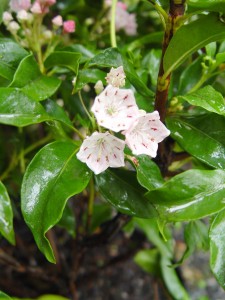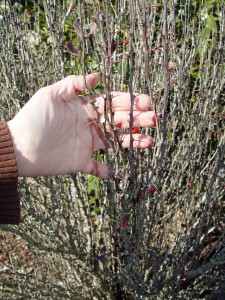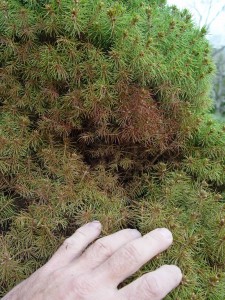Bottom 10 Shrubs
I’m not saying you should never plant any of the following, and it doesn’t mean I hate them either. But these are 10 shrubs you won’t find me planting in my yard.
1.) Mountain laurel (Kalmia). I can’t grow one of these to save my life, and from what I’ve seen in hundreds of other yards, neither can you. Our state flower does fine in the woods when its seed finds a site to its liking. But in our baked-clay yards, it suffers and croaks most of the time.
2.) Heath/Heather (Erica/Calluna). When Longwood Gardens gave up trying to grow these, I knew it wasn’t just me. Heaths and heathers manage to grow in nearly solid rock and other horrific sites so long as the conditions are acidic and free from wild temperature extremes. They do exceedingly well in Scotland and England, but we often get shades of Alaska in winter and weeks worth of Dallas in summer. In other words, we’re not Scotland. Some people manage to keep these alive. Not me.
3.) Burning bush (Euonymus alata). Yardeners love this common shrub for its fire-engine red foliage in fall. In my experience, that lasts about 3 days before the leaves blow into the gutter. The trait that turns me against the burning bush, though, is its bad seeding manners. Gobs of unwanted babies can pop up most anywhere, including in untended areas where they can choke out native and more enviro-useful vegetation.
4.) Barberry (Berberis). Solid clay, parking-lot heat and driveway salt runoff don’t faze this hard-to-kill rounded shrub with the thorns. The compact, burgundy-leafed forms are planted everywhere as a result. I’m not keen on those sharp thorns, but like burning bush, barberry is high on the rampant-seeder list, although a few varieties are nearly sterile.
5.) Rose-of-sharon (Althea). I know a lot of you like this tall shrub for its durability and long-lived flowering. To me, it crosses the line into misbehaving seeder. Too many babies come up in unwanted and invasive situations for me to give it a pass. Sometimes they also get too big for their settings and “bare out” around the legs. There are now some sterile varieties, so stick with these if plant a rose-of-sharon.
6.) Azalea. Sorry, again. I know this is one of our most beloved and planted shrubs, and I really do like them in bloom. The problem is a bug – the lace bug, to be exact. Azaleas are magnets for this juice-sucking bug, leaving so many of them looking a stippled straw brown by season’s end. Azaleas also have a very high initial death rate due to low tolerance for clay soil, wet soil and drought. They really despise the full sun and “builder’s soil” they so often get thrust into.
7.) Dwarf Alberta spruce (Picea alba). This top-selling, slow-growing, pyramidal evergreen flanks so many front doors, but it gives the azalea a run for the dishonor of being the most-killed landscape shrub. Spider mites brown out enough sections of dwarf Alberta spruce to ruin the look, and if not treated, they eventually can kill the whole little tree. Mites are such a common pest here that it’s really not a question of whether your dwarf Alberta will get them, but when.
8.) Variegated euonymus. Like gazillions of rookie gardeners, I was drawn to the bright, variegated foliage of these broadleaf evergreen shrubs. So I bought five for out front. The first year, rabbits gnawed them to the ground. But they grew back. The next year, they got white specks that turned out to be a bug called scale. I learned the bugs were potentially deadly and sprayed to control them. The next year, they were back. I soon caught on that this was going to be a regular occurrence (which it is, from what I see in so many other gardens). So I yanked the five plants and replanted with spireas, which have had no issues in 20 years. Not all types of variegated euonymus always get scale, but it happens enough that I’ll take my chances with something else.
9.) Mugho pine (Pinus mugo). Other than the frequently mispronounced name (it’s “MYOO-go,” not “MUG-ho”), this stiff-needled evergreen is also a big draw for scale. This bug happens to be one of the Big 3 landscape-plant killers (along with lace bugs and mites). I’m not that fond of the coarse texture and prickly feel of mugho pines either, but that’s subjective. Too many better choices…
10.) Pyracantha. This is the fast-growing plant with the orange winter berries and long, stiff thorns. My late parents bought me one of these as my first landscape plant, which I’ve got trained up my chimney. So I don’t have the heart to get rid of this particular pyracantha, which should be classified as a deadly weapon. It bloodies me every pruning, despite big gloves and wary care. I just hope it never gets me in the eye. I also have trouble with a fungal disease rotting the fruits before they turn that showy orange in fall.
I should also mention that Japanese holly has a high first-year death rate; I don’t like how inkberry hollies get bare bottoms and can’t grow uniformly; I see way too many Japanese pieris with root-rot issues and lace-bug damage (ditto for rhododendrons), and forsythia are 2-week wonders that get way too overgrown.










